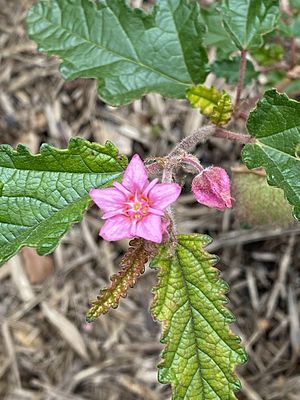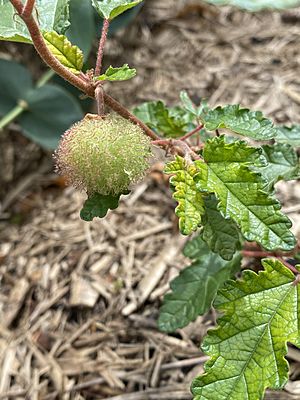Sandy Hollow commersonia facts for kids
Quick facts for kids Sandy Hollow commersonia |
|
|---|---|
 |
|
| Androcalva rosea, in Bowral | |
| Conservation status | |
| Scientific classification | |
| Genus: |
Androcalva
|
| Species: |
rosea
|
The Androcalva rosea, also known as the Sandy Hollow commersonia, is a small and special shrub. It has pretty pink flowers and branches that spread out along the ground. This plant is in danger of disappearing. We only know of four places where it grows naturally. All these spots are in the Hunter Valley area of New South Wales, Australia.
Contents
What Does This Plant Look Like?
The Androcalva rosea is a small shrub that usually grows low to the ground. It can be about 10 to 30 centimeters (4 to 12 inches) tall. Its branches can spread out up to 60 centimeters (about 2 feet) long.
The branches are covered with tiny, star-shaped hairs, especially when they are new. As they get older, they become smoother. The leaves are shaped like narrow eggs or oblongs. They are about 2.4 to 7 centimeters (1 to 3 inches) long and 0.8 to 1.7 centimeters (0.3 to 0.7 inches) wide. Both sides of the leaves have these star-shaped hairs. Each leaf has a small stalk, called a petiole, which is about 4 to 10 millimeters (0.15 to 0.4 inches) long. The edges of the leaves are wavy, and their tips are rounded.
The plant produces 1 to 3 pink flowers together. Each flower has five petals that are shaped like lobes. They grow on a small stalk, which is also covered in star-shaped hairs. The five pink parts that protect the flower bud, called calyx lobes, are also very hairy on the outside.
After the flowers, the plant grows fruits. These fruits are light green at first and turn pale brown as they get older. They are round, like a small ball, and about 1 to 1.6 centimeters (0.4 to 0.6 inches) wide. They are covered with stiff hairs that are 2 to 4 millimeters (0.08 to 0.16 inches) long. Inside, the dark brown seeds are tiny, about 1.5 to 2.5 millimeters (0.06 to 0.1 inches) long. This plant usually blooms, or flowers, from August to February.
How It Got Its Name
The Sandy Hollow commersonia was first officially described in 2004. Two scientists, Stephen Andrew Bell and Lachlan Mackenzie Copeland, gave it the name Commersonia rosea. They published their description in a science journal called Telopea. They studied plants they found near Sandy Hollow.
Later, in 2011, two other scientists, Barbara Ann Whitlock and Carolyn F. Wilkins, changed its name to Androcalva rosea. They published this new name in another science journal, Australian Systematic Botany. The second part of its scientific name, rosea, comes from a Latin word rosaceus. This word means "rosy," which describes the plant's pink flowers.
Where Does This Plant Live?
The Androcalva rosea is very rare. It is only found in four small areas. All these places are within 8 kilometers (about 5 miles) of Sandy Hollow in the upper Hunter Valley. It likes to grow in areas with scrubland and heath vegetation. These are places with small bushes and shrubs. It prefers sandy soils that don't have many nutrients.
Why Is It Endangered?
The Androcalva rosea is listed as "endangered." This means it is at a very high risk of dying out in the wild. Both the Australian Government, under the Environment Protection and Biodiversity Conservation Act 1999, and the New South Wales Government, under the Biodiversity Conservation Act 2016, protect it.
There are several reasons why this plant is in danger:
- Land Clearing: People clearing land for farms or buildings destroys its habitat.
- Fires: Fires that happen too often or at the wrong time can harm the plants.
- Animals Eating It: Goats and rabbits eat the plants, which stops them from growing and reproducing.
- Long Dry Spells: Long periods without rain, called droughts, make it hard for the plant to survive.



